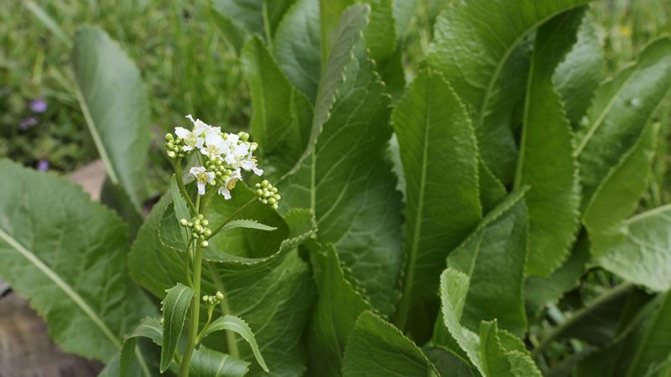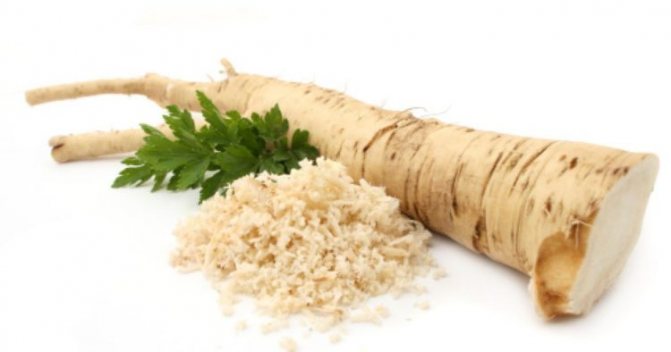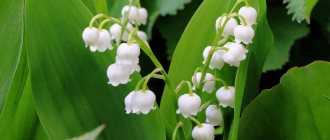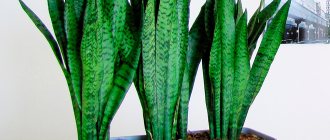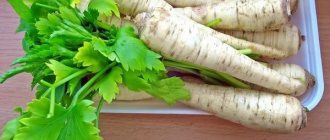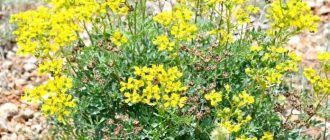The herbaceous perennial plant horseradish (Armoracia rusticana), either village horseradish or ordinary horseradish, is a representative of the Horseradish genus of the Cabbage family (Cruciferous). Under natural conditions, such a plant can be found in the Caucasus, Siberia and Europe, while it prefers to grow in damp places along the banks of various reservoirs and rivers. Horseradish is cultivated in all countries, including Greenland. Already in ancient times in Greece and Rome, people began to eat it. The first written sources where there is a mention of horseradish date back to the 9th century AD, according to scientists, it was at this time that it began to be grown in Russia. It was used as a seasoning for meat and fish dishes, it was added grated to kvass, as well as to various pickles. In Western Europe, or rather, in Germany, such a culture began to be grown again only in the 16th century, they began to season various dishes with it, and also used it as an additive in beer and schnapps. After that, it began to be cultivated in Scandinavia, France and England, where it was also called "horse radish". At this time, horseradish was already used, not only adding to various dishes, but also as a folk remedy with powerful healing properties.
Brief description of cultivation
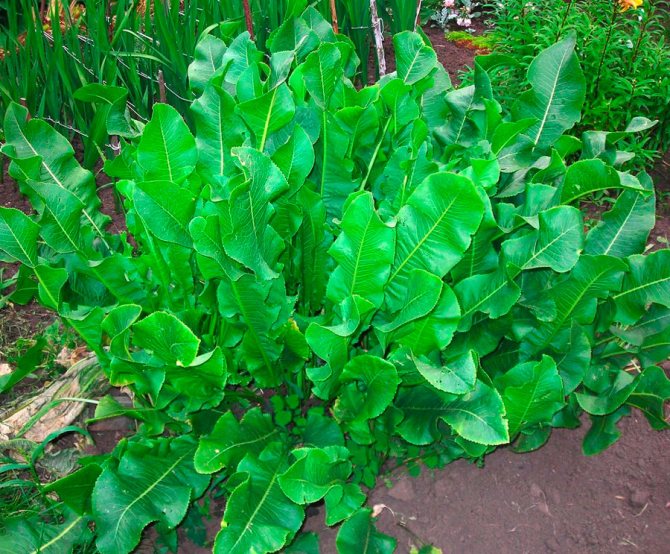
- Landing... In the last days of March or in the first days of April.
- Illumination... Needs the bright light of the sun.
- Priming... Sandy loam, loamy or chernozem soil, which must be nutritious.
- Watering... It is necessary to water systematically, while 1 to 2 buckets of water should go per 1 square meter of the plot. If it rains regularly in the summer, then horseradish can do without watering.
- Fertilizer... The first time they feed after the formation of the first true leaf plates, for this they use a solution of complex mineral fertilizer. After 15–20 days, re-feeding is carried out, for this they use organic matter, or rather, a mullein solution.
- Reproduction... Vegetatively (by parts of the rhizome), less often the seed method is used.
- Harmful insects... Cruciferous fleas, rapeseed bugs and flower beetles, cabbage bugs and moths.
- Diseases... White rot, leucorrhoea, verticillosis and viral mosaic.
How to grow, care and pests and diseases
To grow horseradish, you should choose a fertile loamy land filled with organic substances. It is best to plant cuttings along the ridges at an angle, so that the upper end is above the ground. The best time for planting is late spring, but summer or fall is also fine.
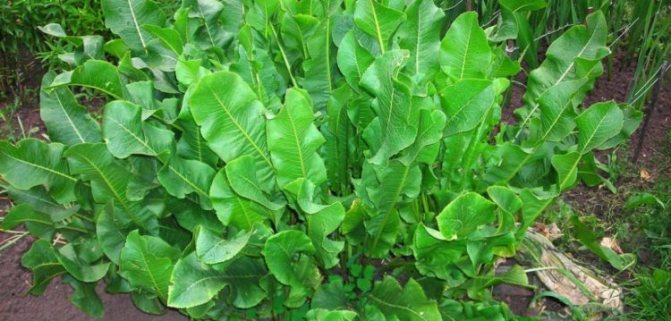

After that, the plant will need to be regularly fed and watered. Also, do not forget about loosening the soil and controlling weeds. All this will help protect the plant from such a pest as the cabbage leaf beetle, which comes out of wintering at the beginning of summer.
Horseradish blooms in the second year after planting in May-June, and in August it will already be possible to pick off the leaves of the plant and use them to prepare pickles.
Horseradish features


Horseradish forms a fleshy and thick root crop. The stem is straight and branched, its height can vary from 0.5 to 1.5 meters.Very large crenate basal leaf plates have an oblong-oval shape, while at the base they are cordate. The upper leaf plates are whole-edged linear, while the lower ones are pinnately separate. In white flowers, the length of the petals reaches 0.6 cm. Fruits are swollen, oblong-oval-shaped pods, the length of which is 0.5–0.6 cm, on the surface of the valves there is a reticulate-vein pattern. Inside the pods are nests containing 4 seeds. This perennial plant is distinguished by its amazing unpretentiousness and frost resistance. Having planted it once, it will be impossible to get rid of it, since it behaves extremely aggressively, akin to weed grass.
Each part of the bush contains an essential oil with a pungent smell and taste. The root juice of such a plant contains ascorbic acid, thiamine, riboflavin, carotene, starch, carbohydrates, fatty oil, resinous substances and the protein lysozyme, which has a powerful antimicrobial effect. The root vegetable contains mineral salts of calcium, potassium, magnesium, sulfur, phosphorus, copper and iron. Official medicine has known for a long time that horseradish has powerful medicinal properties, so it helps to improve intestinal activity, has a choleretic, antiscorbutic and expectorant effect. It is used in the treatment of diseases of the digestive tract, liver and bladder, colds, gout and rheumatism.
Useful properties of leaves and root
The benefits and healing effects of the plant are simply invaluable. The rich vitamin composition of horseradish makes it possible to use the leaves and root in traditional medicine. Of greatest interest is the root part of the plant, which includes:
- ascorbic acid;
- vitamins PP, B;
- carbohydrates (arabinose, sucrose, galactose, etc.);
- galacturonic acid;
- saponins;
- mustard oil and other substances.
The leaves are also valuable in medicine and cosmetology due to the content of the following components:
- vitamins B, C, PP;
- mineral salts of nitrogen, potassium, etc.


Flower on horseradish plant
Horseradish flowers are of no less interest for traditional medicine. They are harvested in the middle of the flowering period. It was at this time that the inflorescences are maximally enriched with useful substances that have a beneficial effect on the human body.
Useful properties of culture:
- improves brain function, strengthens memory, restores vision;
- increases reproductive function in men;
- normalizes the digestive system, improves metabolism;
- eliminates diseases of the oral cavity (good for teeth and gums);
- neutralizes the effect of tobacco and alcohol, which makes it possible to supplement addiction treatment with horseradish remedies;
- cleanses the intestines from toxins, decay products and harmful microorganisms.
Horseradish belongs to low-calorie foods, 100 gr. contains only 48 Kcal.
Harm and contraindications for the body
Now let's see if there is any harm from the plant and why. Horseradish refers to products that irritate the mucous membrane, so the use of different dishes with it or medicines should be limited. A positive effect can be achieved only with a short use of the leaves or root of the plant.
Contraindications for use are the following diseases:
- ulcers of the stomach and duodenum;
- gastritis, which has developed against a background of high acidity;
- edema due to renal failure;
- disorders of the kidneys and liver.
Allergy sufferers should pay special attention to avoid exacerbation of the disease. The plant contains components that are considered allergy pathogens.


Horseradish harvest
Planting horseradish in open ground


What time to plant
Horseradish planting in open soil is carried out in early spring, or rather, in the last days of March (if it is warm) or in April. This culture is not afraid of any frost or cold snap.A small, well-lit area located near the fence is perfect for planting such a plant.
The most popular is the vegetative method of horseradish propagation by parts of the rhizome. However, it is quite possible to grow it from seeds, but this method is relatively laborious, for which gardeners do not like it.
Horseradish soil
This culture grows well in nutrient soil, which can be black soil, loam or sandy loam. If you properly prepare clay soil, then such a plant will develop and grow on it within normal limits. To do this, in the autumn months, during the digging of such a site, sand, peat, and manure should be added to the ground (per 1 square meter from 10 to 12 kilograms). At the same time, minerals are introduced into the soil in the spring: 30 grams of superphosphate, potassium salt and ammonium nitrate per 1 square meter of the plot. If, for the cultivation of such a root crop, a site with a suitable soil for it is selected, then organic fertilizers are recommended to be applied under the previous crop, for example: legumes or cereals.
Landing rules
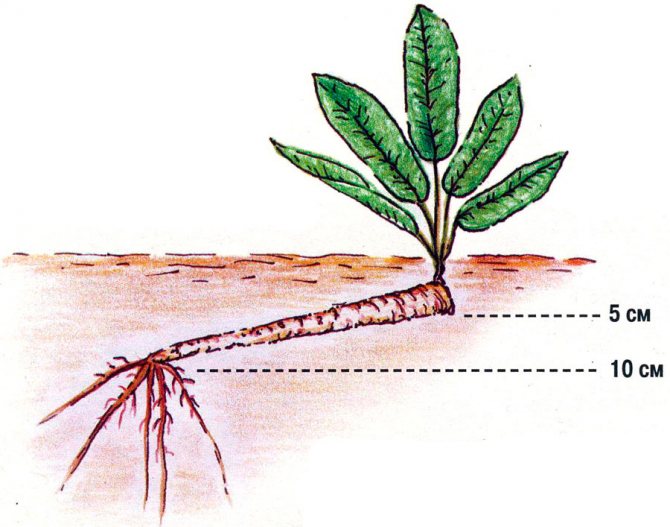

Harvesting of root cuttings should be carried out in autumn along with harvesting. They are stored for storage in a cellar or basement, buried in dry sawdust or sand. Harvesting of root cuttings can be carried out at the beginning of the spring, before leaf plates appear on the bushes. When 10-15 days remain before planting in the ground, the cuttings should be taken out of storage and, covered with a damp cloth, removed to a warm place. This is necessary in order for the buds to germinate.
Before proceeding with the planting, lateral processes must be separated from the main root, the length of which should not be more than 25 centimeters, and in diameter they should reach up to 1.2 centimeters. If the stalk is very long, then it must be divided into parts, while the lower cut should be oblique, and the upper cut horizontal. Then they are planted on a previously prepared site, while it should be borne in mind that there should be no more than 4-6 bushes on 1 square meter. When planting cuttings, the distance between them should be from 0.3 to 0.4 m, and the width between the rows must be maintained within the range from 0.65 to 0.7 m. To harvest a rich crop of even root crops, the cuttings must be prepared before planting. For this, take a coarse tissue and rub the middle part of the cutting with it, as a result, you will remove excess buds from it, while leaving only the upper buds for the formation of foliage and the lower ones for the formation of the root system. When planting such a vegetable in order to obtain planting material, it is not necessary to remove sprouted buds from the cutting, in this case the root of the bush will be very branched and a large number of cuttings can be obtained.
It is necessary to plant cuttings in open soil at an angle, while their top is buried only 50 mm into the ground, and the lower part - 100 mm. For the reproduction of such a vegetable, small pieces of roots are also suitable, the thickness of which should be no more than 25 mm, and the length - up to 80 mm, they must be planted horizontally in the soil, while it is not necessary to remove the buds from them.
Planting horseradish before winter
This plant is planted in the ground in the autumn in the same way as in the spring. In this case, it is recommended for him to choose a site where tomatoes or potatoes were previously grown, while all the necessary organic matter must be introduced into the soil before planting such crops. All weeds and plant residues must be removed from the site, and when it is dug up, you can start planting horseradish. It is best to plant horseradish before winter in mid-October.
Varieties, types and their photos
You should choose a variety according to zoning (varieties for the Middle Lane are not suitable for Siberian frosts). Also pay attention to the characteristics of the variety (when ripe, etc.).
Suzdal
Has an even root without branches, length up to 30 cm, dense juicy root crop. A well-proven variety.


Atlant
A variety that is resistant even to severe frosts and droughts. Optimal for the harsh Siberian and Far Eastern climates. Good storage quality, crispy white root pulp. Mid-season.


Valkovsky (Wild)
A late-ripening variety with a juicy white root vegetable pulp. Relevant for home preservation preparations.
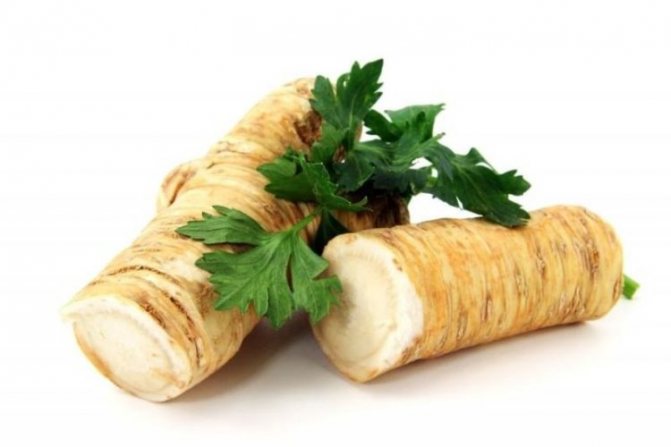

Latvian
Well suited for Central Russian regions.


Tolpukhovsky
Smooth roots of regular shape, juicy white flesh. The variety winters well, in this regard, it is sometimes preferred to grow it for the sake of spicy leaves, while the roots are left in the ground for the winter.


Japanese wasabi
It belongs to exotic species. It is not resistant to temperature extremes, so in cooler climates it is more likely to grow successfully in a greenhouse than outdoors. When grown without a greenhouse, you need to maintain sufficient moisture, cover from the sun and mulch to prevent overheating.
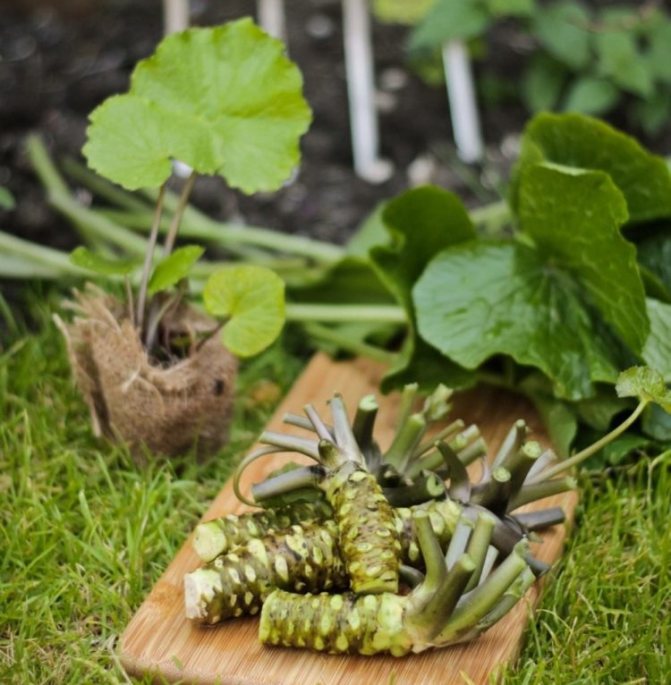

Horseradish care


After horseradish sprouts appear from the soil, they must be thinned out. During this procedure, it is necessary to remove all weak and poorly developed shoots, leaving the most powerful ones. In July, lateral branches are trimmed from the root crop, for this it should be carefully excavated and all available lateral roots removed from its upper part (up to 0.25 m). When all the rhizomes have been processed, they are again carefully covered with soil, which is then thoroughly compacted and watered. At the same time, try to avoid voids near the rhizome. The rest of the care for such a plant is very simple, it must be watered, weeded, loosened up the soil surface near the bushes in a timely manner, and also provide protection from various harmful insects and diseases.
Watering
Throughout the growing season, watering such a vegetable should be systematic. During this procedure, 1–2 buckets of water should be consumed per 1 square meter of the plot. Particular attention is paid to watering during a prolonged drought. If it rains systematically in the summer, then horseradish can do without watering at all, since if liquid stagnates in the soil, then rot may appear on the roots, which will cause the loss of the entire crop.
Fertilizer


After the first leaf plates appear, the bushes should be fed with a mineral complex, for this, 8 grams of superphosphate, 5 grams of ammonium nitrate and the same amount of potassium salt are taken per 1 square meter of the garden. If the growth and development of the bushes is very slow, then 15–20 days after the first fertilization, they must be fed with a mullein solution (1:10).
Horseradish pests and diseases


Horseradish is more resistant to diseases than other crops belonging to the Cruciferous family. If such a plant is poorly looked after or does not provide optimal conditions for growth, then the bushes can be affected by linen, mosaics, white rot or verticillosis. Such a root vegetable can be harmed by cruciferous fleas, rape bugs and flower beetles, cabbage bugs and moths.
Today, viral diseases are considered incurable, so if horseradish strikes a mosaic or verticillary wilting, then such bushes must be dug up and destroyed. If the plant is affected by white rot or linen, which are fungal diseases, then they can be cured only at the very beginning of the development of the disease. To do this, they are treated with a solution of the drug containing copper (for example: copper sulfate, Tiovit Jet, Bordeaux liquid, Oxychom or another similar agent).
In order to prevent the appearance of harmful insects on the plants, it is necessary to adhere to the rules of agricultural technology of this crop: observe the rules of crop rotation, remove weeds from the site in time, when the harvest is collected, the site must be cleared of plant residues, and then it is deeply digged. Insecticidal preparations can also help in pest control. If bugs and fleas have settled on the bushes, then they need to be sprayed with a solution of Foksim or Aktellik, fireflies and flower beetles are destroyed with Etaphos, Tsimbush or Zolon.
Please note that all chemical treatments should be discontinued 20 days before harvest. It should be remembered that the bushes weakened by improper care most often get sick, and harmful insects also prefer to settle on them. And if you take care of horseradish correctly and adhere to the rules of agricultural technology, then you will be able to protect it from many diseases and pests.
The benefits and harms of a vegetable


Our ancestors knew about the benefits of horseradish centuries ago. This is not only a seasoning, but also a medicinal plant known for its medicinal properties.
Horseradish is good because:
- helps digestion;
- stimulates the secretion of gastric juice during meals;
- increases appetite;
- improves bowel function;
- contains vitamins;
- disinfecting volatile substances (phytoncides).
We offer you to watch a video about the useful and harmful properties of horseradish:
Horseradish cleaning and storage


Already in August, they begin to cut horseradish foliage, it is used as a spice during the canning of tomatoes, cucumbers and other vegetables. At the same time, remember that if you cut off all the leaf plates from the bush, then this will have an extremely negative effect on the development of the rhizome. Foliage pruning should be carried out at a height of 10 to 15 centimeters from the soil surface, in this case, both the apical bud and the leaf will remain unharmed.
Mass harvesting of root crops is carried out in the last days of October or the first - in November, before the frost begins, at which time the foliage turns yellow and begins to dry out. When planting large cuttings, harvesting is carried out in the same season. If relatively small root cuttings were planted, then normal root crops from them will grow only in the next season. Before you start harvesting, you need to cut off all the foliage from the bushes, then dig up the rhizome with a shovel and pull it out of the soil. Remember that if at least a few pieces of small roots remain in the ground, then next year they will look more like weeds. As soon as the roots are removed from the soil, they need to be removed to a cool room without tightening. Then, soil residues and side branches are removed from them, the cuts must be coated with iodine. To dry, horseradish is removed in a warm, well-ventilated place for 24 hours.
For storing root crops, wooden boxes are used, on the bottom of which a layer of soil must be poured, while they are laid out on it in rows so that their surfaces do not touch each other. After the row of horseradish has been laid, it should be sprinkled with clean sand. When the vegetable is placed in boxes, it is stored in the cellar or basement. For storage, the root crop can also be put on the refrigerator shelf, but in this case its length should not exceed 0.3 m, while each of them must be wrapped with cling film, in which do not forget to make several holes for ventilation. On a vegetable shelf in the refrigerator, horseradish retains its properties for about 20 days. In frozen form, it can be stored for up to 6 months, for this, the skin is removed from the root crop and cut into cubes, after the moisture that has come out from them is removed (you can use napkins) they are poured into a plastic bag and put into the freezer.
Horseradish can be dried if desired. To do this, the root should be cut into small slices, which are laid out on a baking sheet in 1 layer, after which it is removed in the oven for 90 minutes. the temperature should be no more than 60 degrees. The dry and hardened root is crushed, for this you can use several devices: a grater, a coffee grinder or a mortar. The resulting powder must be poured into a container made of porcelain or glass, which is closed with a lid. Before using the ready-made powder for its intended purpose, it must be mixed with water so that it is soaked. The shelf life of dried horseradish is no more than two years.
Such a vegetable can be pickled.To do this, take 1 kilogram of root vegetables, which need to be peeled and rinsed. They are rubbed on a grater or passed through a meat grinder, and the resulting mass is tightly placed in a glass jar, which must be sterilized in advance, after which the marinade is poured into the container. For its preparation in 1 tbsp. put boiling water in 1 large spoonful of salt and granulated sugar, when the marinade is removed from the stove, add ½ tbsp. apple cider vinegar (6%). If desired, you can use 1 large spoonful of citric acid to replace the vinegar. The freshly boiled marinade is poured into a horseradish jar, which is rolled up with a pre-sterilized metal lid. The pickled vegetable retains its properties for several years.
How to get out of the garden?
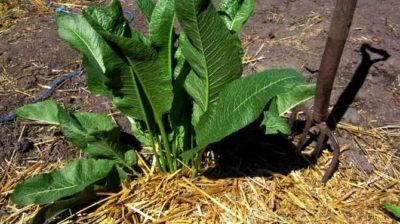

Horseradish has a "superpower" to capture large areas and can easily spread throughout the entire site. The root system sometimes reaches seven meters! Even from a small piece of root left in the ground, a new bush will sprout up in the spring. What to do?
- The most environmentally friendly and effective way: we close the first shoots of horseradish in the spring with any opaque material. In the dark, horseradish will not be able to grow and will die. The procedure may need to be repeated next year. It depends on how powerful the root system is in the ground.
- Another option is herbicides, chemicals that kill the plant.
Attention! The method is dangerous, not environmentally friendly! Be careful not to damage other plants in the area.
The fight against horseradish in the garden can last for more than one year. It is optimal from the very beginning to prevent horseradish from spreading throughout the site by digging metal sheets into the ground around the garden bed. Or place an iron box or barrel in the ground and plant horseradish in it.
We offer you to watch a video on how you can get horseradish out of the garden:
Recipes from this plant for healing
Salt deposits
Required:
- Young horseradish leaves.
- Boiling water.
- Film (scarf or shawl).
Preparation:
- The leaves are poured over with boiling water.
- Apply to the affected area on the thoracic, cervical or lumbar region.
- The compress is left overnight, secured with a film and, if desired, additionally covered with a warm scarf or scarf.
- In the morning, the compress is removed. A white coating remains on the skin - this is the salt that horseradish pulled out. The plaque needs to be erased.
- Compresses are done in a ten-day course. If the patient's condition suggests that during this time the final result has not been achieved, the treatment can be continued.
Video about using horseradish leaves to remove salts from the body:
Osteochondrosis
Alcohol tincture of horseradish leaves is perfect for treating osteochondrosis, both by ingestion and rubbing during massage.


For manufacturing you will need:
- Fresh horseradish leaves.
- Good quality vodka.
Cooking method:
- Wash the leaves, dry them, fill a small glass jar with them.
- Pour vodka to the top, close tightly and put in the refrigerator.
- After a week, the tincture can be consumed after being filtered.
When taken orally, one tablespoon of the tincture is mixed with a small amount of honey and taken several times a day, in a course not exceeding two weeks.
Cleansing the body
Required:
- Chopped horseradish leaves - 1 cup.
- Wine - 4 glasses.
Preparation:
- Put the crushed raw materials in a glass container, pour over with wine, cover and leave in a dark place for two weeks at room temperature.
- After the allotted time, strain the tincture and use one tablespoon half an hour before meals.
- The course can last from one to three months.
Fighting excess weight
In order to lose weight, the use of horseradish salad will be very effective.
Ingredients:
- Celery - 300 gr.
- Horseradish leaves - 200 gr.
- Kefir or yogurt - 1 glass.
Preparation:
- Grate celery on a coarse grater.
- Chop horseradish leaves.
- Pour kefir over all ingredients.
- Divide the salad into two portions and eat it once a day.




